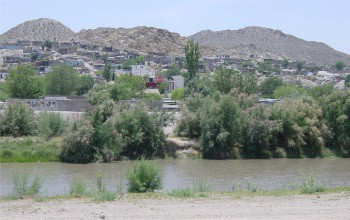Ciudad Juarez: Terror In The Valley
by John Murray

On Monday, just after the conclusion of a wedding ceremony, a group of armed men burst into a Juarez church and ordered everyone down on the floor. Moving quickly, they collected the groom, his brother and their uncle and led them out. When another man tried to intervene, they shot him dead. The three relatives were then thrown into a truck and disappeared. On Wednesday, state police found their bodies in the bed of an abandoned pickup in the eastern sector of the city. They had been tortured for many hours before they were killed. It was a particularly horrifying example of the fact that violence in Juarez can strike anytime, anywhere.
The men turned out to be US citizens from New Mexico. The signs of torture and the fact that they were selectively targeted leads to the conclusion that they were involved in the drug trade, and that this was some kind of settling of scores. But without discounting the motive, the event illustrates just how little regard the perpetrators of this violence have for the citizens of Mexico, despite the odd status of smugglers as cult and folk heroes. An attack on a church, during a wedding, in a fervently Catholic country is a serious event. Whether the symbolism of the violation in this particular case was intentional or not, it transmits a clear message that, for the cartels, nothing in Juarez is sacred.
A lot of the violence in the city has been characterized by this kind of symbolism. Bodies have been dumped on many occasions in lots and playgrounds near schools, with children gathering around the crime scene to watch as police bag and remove the dead. Drug rehab clinics have been the scenes of mass murders. People are shot down in broad daylight during the normal hubub of everyday life, on main streets and in restaurants. Considering this, it’s clear that what’s happening isn’t just a war between rival cartels, but a campaign of terror against the local population. The murdered groom’s father conveyed perfectly the effect of this kind of violence to the El Paso Times: “I’m confused, frustrated and in despair. My wife, she is devastated.” There really aren’t any better emotions you could hope to inspire in a population you’re trying to control.
This trend is best illustrated these days in the Valley of Juarez, the stretch of towns scattered along the Rio Grande southeast of the city for about 50 miles. The valley has long been as important as the city itself for drug traffickers. During the dry season the river drops to barely a trickle and crossing by foot is a breeze. With I-10 running right alongside it through Texas towns like San Elizario, Fabens and Fort Hancock, it’s tactically perfect for smuggling. The towns on the Mexican side, like Guadalupe and Porvenir, are poor agricultural communities that mainly grow cotton. However, they’ve also grown accustomed to smuggling over the years, as the Juarez cartel used the area as a staging point for trafficking operations for decades.
With the voracious Sinaloa cartel now fighting for the territory, the Valley of Juarez has become an arena for a campaign of terror bent on forcing out the locals who have been used to Juarez cartel rule for so many years. Homes have been burned down, a state investigator murdered, and people have been kidnapped and not turned up again with no calls demanding ransom.
A week before Easter, typewritten messages spread around Porvenir that anyone who hadn’t left the area by Easter Sunday would be killed. Citizens packed up and left in droves. While no such large scale attack ever came, the assault on the social climate of the community was enough. Residents were threatened with death on the most holy day of the Catholic calendar. Like this week’s wedding murders, the sanctuary of religion was directly challenged when the main church in town was burned to the ground on Good Friday.
The campaign is working. US authorities have seen a huge jump in the number of asylum requests from citizens of the valley. Porvenir, once home to 3000 residents, has now been reduced to just a few hundred.
A writer at Mexican daily El Diario called the actions of the Sinaloans nothing more than a ‘scorched earth’ policy, and it is an assertion that is hard to argue with. With so many forces fighting for control of Juarez-the cartels, the army and now the Federal Police-the city really doesn’t belong to its citizens anymore. What they once considered home they are now finding out belongs to someone else, expressed quite literally in the fight for the control of “turf.”
In the US we talk a lot about “not letting the terrorists win” by giving in to fear. It’s very hard to look at Juarez, just over the river, and see terror not only succeeding, but ruling. In a city where US business interests play such a prominent role, it’s harder still to talk about defending democracy when the mayor of Juarez, Jose Reyes Ferriz, keeps his family in El Paso due to constant death threats and the country’s prominent political parties can’t find anyone willing to run in July’s mayoral elections except the man who was mayor previous to Reyes Ferriz. It would be tough to find a more fitting example of the fact that the outcome of this war won’t be any step in a new direction for Juarez. It’s a reminder that history seems doomed to repeat itself in this city that has become an allegorical ground zero for the violent, protracted stalemate of Mexico and America’s war on drugs.
Previously: How This War Is Not Like Colombia, Italy and Chicago
John Murray is a lover of obscurity. He lives and writes in Arizona.
